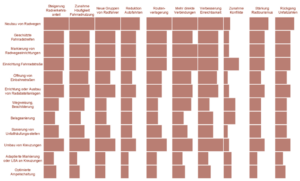VERA research project: Which measures increase cycling?

Assessing the impact of cycling measures is a key challenge in transport planning. The VERA research project, which was carried out as a co-operation between the Cycle Competence members University of Salzburg and Herry Consult with the Technical University of Dresden and the company EBP Schweiz AG, dealt with this issue. The most important finding of the study: nothing promotes cycling better than newly built cycle paths! In second place comes the opening of one-way lanes, which is a very cost-efficient measure. A guideline is now available to help with the assessment of effectiveness.
VERA guidelines as a planning aid for cycling infrastructure measures
Previous methods for impact assessment are often based on data-intensive mathematical models or individual expert estimates. In VERA, reliable answers were sought through a combination of literature research, expert surveys and empirical studies, while at the same time minimising data requirements. The central result is the guidelines obtained, which provide decision-makers with a sound basis for the design of efficient cycling infrastructure.
For the planning and implementation of new cycle paths or improvements to existing cycling facilities, it is crucial to be able to estimate the expected modal shift effect of the respective measures in advance. The VERA guide provides decision-makers in the DACH region with a methodological tool for estimating these modal shifts. It aims to provide practical and easy-to-implement solutions for the planning of cycling measures that can be used by both large cities and smaller municipalities. The aim is to optimise the use of available financial resources and create an evidence-based basis for conflicts of interest.
Empirical findings from millions of recorded bike journeys
To ensure that VERA can make highly relevant and reliable statements, the project’s findings are based on a combination of literature analysis, expert consultation and empirical analysis. The empirical analysis consists of several million recorded cycle journeys (trajectories); in addition, data was collected from stationary counting point data and mobility surveys. In cooperation with municipalities and regions, the effects of measures were then analysed and combined with the results from literature and expert surveys so that a systematic and data-based evaluation could take place. This type of data collection is new for the DACH region, as previous evaluations of measures tended to be based on individual expert estimates.
New construction of cycle paths as the most effective measure
The following impact matrix emerged from the results, which shows the impact of various measures:
Matrix from the consultations of the 169 experts on the effects of the measures
This impact matrix can also be found in the guidelines and can be used, for example, if no structured before/after measurement data is available for the implementation of measures. In addition, two models were developed to determine the effectiveness of measures on the basis of empirical analyses. From this it can be deduced that
- the construction of new cycle paths increases cycle traffic by 70%
- the opening of one-way lanes by 56 %
- renovating the road surface by 48 %
- the expansion of the existing cycle path network by 37 % and
- the marking of cycle paths by 36 %.
Apart from the individual measures, results show that bundles of measures as part of a comprehensive strategy have the strongest effect.
The following figure shows the assumptions derived from the literature analysis and expert survey on the shift effect from car to bicycle (proportion of additional cycle routes previously undertaken by car), broken down by type of measure.
Shift effects to cycling depending on the measure
Four steps to more cycling
The centrepiece of the project is the guideline, which has already been tested in several municipalities. It is now available as a methodological tool for decision-makers. The guideline comprises four consecutive steps. Depending on the availability of data (expressed by level A, B, C), the volume of cycling traffic at the location where the measure is to be implemented is measured or estimated (step 1). In the second step, the modal shift potential of the various measures for cycling is determined. The modal shift potential shows the factor by which the cycling traffic figures at the location of the measure increase as a result of the respective measure. The proportion of car journeys is estimated from the number of journeys shifted (step 3). Finally, in the fourth step, the expected emission reductions due to saved car kilometres can be derived from these shifted trips.
In order to maximise the effects of cycling measures, the guidelines recommend various accompanying measures such as high-quality parking facilities, information on cycling routes, repair and maintenance options or networking with public transport. It also recommends incentivising local authorities to invest in data collection and provision. A continuous survey of cycling traffic volumes is not yet common practice in the DACH region. The VERA project’s method could therefore be expanded by improving the data situation.
Download the results report including the guideline here
Duration of the project was November 2022 to October 2024
All illustrations are from the VERA results report Rendering: ZoomVP/Bicycle Vienna
Cycling Competence Members in this article:
More articles with this member:
[crp]
Share this article:
VERA research project: Which measures increase cycling?
Share this article:

Assessing the impact of cycling measures is a key challenge in transport planning. The VERA research project, which was carried out as a co-operation between the Cycle Competence members University of Salzburg and Herry Consult with the Technical University of Dresden and the company EBP Schweiz AG, dealt with this issue. The most important finding of the study: nothing promotes cycling better than newly built cycle paths! In second place comes the opening of one-way lanes, which is a very cost-efficient measure. A guideline is now available to help with the assessment of effectiveness.
VERA guidelines as a planning aid for cycling infrastructure measures
Previous methods for impact assessment are often based on data-intensive mathematical models or individual expert estimates. In VERA, reliable answers were sought through a combination of literature research, expert surveys and empirical studies, while at the same time minimising data requirements. The central result is the guidelines obtained, which provide decision-makers with a sound basis for the design of efficient cycling infrastructure.
For the planning and implementation of new cycle paths or improvements to existing cycling facilities, it is crucial to be able to estimate the expected modal shift effect of the respective measures in advance. The VERA guide provides decision-makers in the DACH region with a methodological tool for estimating these modal shifts. It aims to provide practical and easy-to-implement solutions for the planning of cycling measures that can be used by both large cities and smaller municipalities. The aim is to optimise the use of available financial resources and create an evidence-based basis for conflicts of interest.
Empirical findings from millions of recorded bike journeys
To ensure that VERA can make highly relevant and reliable statements, the project’s findings are based on a combination of literature analysis, expert consultation and empirical analysis. The empirical analysis consists of several million recorded cycle journeys (trajectories); in addition, data was collected from stationary counting point data and mobility surveys. In cooperation with municipalities and regions, the effects of measures were then analysed and combined with the results from literature and expert surveys so that a systematic and data-based evaluation could take place. This type of data collection is new for the DACH region, as previous evaluations of measures tended to be based on individual expert estimates.
New construction of cycle paths as the most effective measure
The following impact matrix emerged from the results, which shows the impact of various measures:
Matrix from the consultations of the 169 experts on the effects of the measures
This impact matrix can also be found in the guidelines and can be used, for example, if no structured before/after measurement data is available for the implementation of measures. In addition, two models were developed to determine the effectiveness of measures on the basis of empirical analyses. From this it can be deduced that
- the construction of new cycle paths increases cycle traffic by 70%
- the opening of one-way lanes by 56 %
- renovating the road surface by 48 %
- the expansion of the existing cycle path network by 37 % and
- the marking of cycle paths by 36 %.
Apart from the individual measures, results show that bundles of measures as part of a comprehensive strategy have the strongest effect.
The following figure shows the assumptions derived from the literature analysis and expert survey on the shift effect from car to bicycle (proportion of additional cycle routes previously undertaken by car), broken down by type of measure.
Shift effects to cycling depending on the measure
Four steps to more cycling
The centrepiece of the project is the guideline, which has already been tested in several municipalities. It is now available as a methodological tool for decision-makers. The guideline comprises four consecutive steps. Depending on the availability of data (expressed by level A, B, C), the volume of cycling traffic at the location where the measure is to be implemented is measured or estimated (step 1). In the second step, the modal shift potential of the various measures for cycling is determined. The modal shift potential shows the factor by which the cycling traffic figures at the location of the measure increase as a result of the respective measure. The proportion of car journeys is estimated from the number of journeys shifted (step 3). Finally, in the fourth step, the expected emission reductions due to saved car kilometres can be derived from these shifted trips.
In order to maximise the effects of cycling measures, the guidelines recommend various accompanying measures such as high-quality parking facilities, information on cycling routes, repair and maintenance options or networking with public transport. It also recommends incentivising local authorities to invest in data collection and provision. A continuous survey of cycling traffic volumes is not yet common practice in the DACH region. The VERA project’s method could therefore be expanded by improving the data situation.
Download the results report including the guideline here
Duration of the project was November 2022 to October 2024
All illustrations are from the VERA results report Rendering: ZoomVP/Bicycle Vienna
Cycling Competence Members in this article:
More articles with this member:
[crp]



